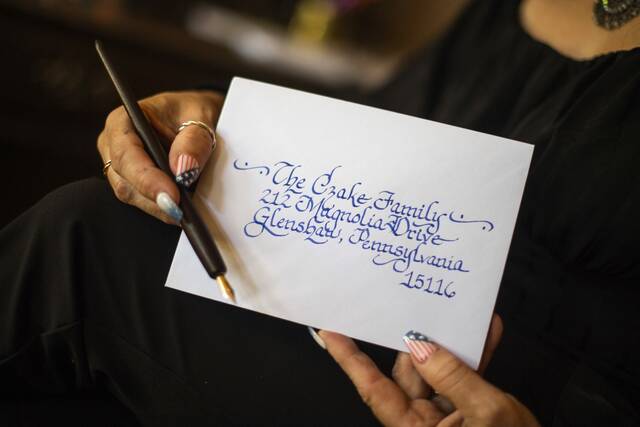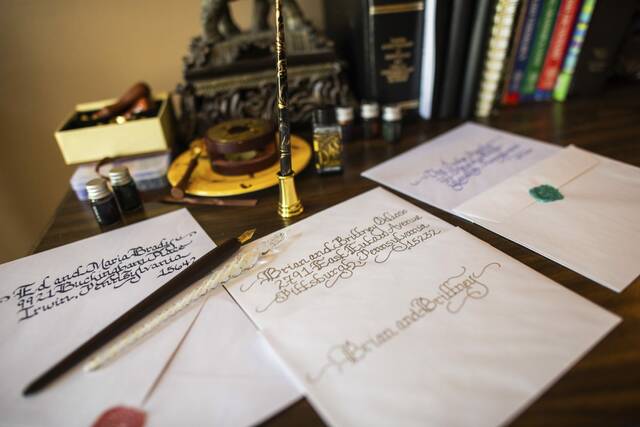Norwin instructor teaches ancient art of calligraphy
A Norwin instructional aide who has mastered the art of calligraphy — an elegant handwriting style practiced centuries ago in China, Greece, Rome and Egypt — is sharing her expertise with today’s middle school students.
“Calligraphy fits in well in that period because it was a time when the art of calligraphy flourished,” said Kandee Lojas, 55, of North Huntingdon, who teaches seventh and eighth graders calligraphy while they are learning about ancient history.
Lojas connects her artistic skills with the Middle Ages and Renaissance curriculum taught by Norwin’s global studies teachers. She gives students a quick 10-minute history of calligraphy to give them an understanding of how it fits into history, said Superintendent Natalie McCracken.
Students also learn how calligraphy is part of the Muslim world, with major religious monuments adorned with it, Lojas said. Centuries ago, Christian monks in Europe hand wrote books and Bibles in calligraphy, creating what are described as illuminated manuscripts.
To give the students an idea of the time required for the monks to copy the 780,000 words of the King James version of the Old Testament, Lojas counts how many words a student can write in calligraphy in a minute. By extrapolating that number of words they have written in 60 seconds — typically one or two — it would take a student almost two years to reproduce the Bible, Lojas said.
The students are “amazed” when they are told how long it takes to write a book, Lojas said.
“Through the lesson’s hands-on activities, students better understand the painstaking efforts required to write text by hand and why handwritten books during that time period were so rare and valuable. This also helps students to have a greater appreciation for the change brought about by the printing press,” the superintendent said.
Calligraphy receded in popularity in the Middle Ages, with the rise of printing presses, Lojas said.
Different strokes
When working with the students who are accustomed to typing words on a computer or their smartphone, Lojas uses a variety of ink pens with different nibs, or points. The angle of the wrist and pressure applied to the pen can produce a different fonts — a thinner, more fine letter or a thicker version.
Students have the important opportunity to practice their signatures and experimentwith various fonts and pen colors and sizes, McCracken said. Lojas provides the pens and ink for the instruction.
“The students really enjoy it. Many go on to buy their own pens and continue writing on their own,” McCracken added.
Although it would seem to reason that students who have trouble with handwriting writing would have difficulty with calligraphy, Lojas said that “some of the best student calligraphers have terrible handwriting.”
“Once they pick up an ink pen, it makes them take their time and they write beautifully,” she said.
Lojas, who has taught at Norwin for 14 years, believes that middle school is an ideal time to introduce students to calligraphy.
“They’re mature enough and they’re finding their artistic ability,” she said. “If I can keep at least one kid a year interested in keeping at it (calligraphy), that would be great.”
Early beginnings
A native of Harrison City, Lojas began learning calligraphy in eighth grade while a student at Penn-Trafford.
“I always did well with cursive” handwriting, Lojas said. After graduating from Greensburg Central Catholic, she enhanced her calligraphy skills by taking a class at Seton Hill University in Greensburg.
Having earned a degree in sociology and criminal justice from Saint Vincent College near Latrobe, she spent 12 years working at the Westmoreland County Children’s Bureau and also served as a probation officer for the county. All the while, she never let calligraphy slip into her past.
She wrote her own wedding invitations in 1992, sending them to the 250 guests she and her fiance, John, had invited.
She also began creating certificates of achievement and wedding invitations for others. Most of the customers for her cottage business come from ‘word of mouth,” Lojas said, explaining that she receives requests from people who have seen her work or received one of the wedding invitations she has written.
She plans to write the wedding invitations for her son, Remington Lojas, when he gets married in 2025 and anticipates doing the invitations for the 2026 wedding of her daughter, Brittney.
“It’s a part of history and there are still a few people doing it. I’ll continue to do this. You can do it, no matter what the age,” Lojas said.
Joe Napsha is a TribLive reporter covering Irwin, North Huntingdon and the Norwin School District. He also writes about business issues. He grew up on Neville Island and has worked at the Trib since the early 1980s. He can be reached at jnapsha@triblive.com.
Remove the ads from your TribLIVE reading experience but still support the journalists who create the content with TribLIVE Ad-Free.




